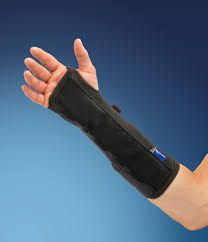
PRIMO ORTHOCARE SDN BHD
TFCC Wrist Orthosis
TFCC Wrist Orthosis

Triangular Fibrocartilage Complex (TFCC) Injuries
Injuries to the Triangular fibro cartilage complex; TFCC, are common after distal radius fractures. Up to 40% of these patients have injuries to the ligament complex. TFCC injuries are also common in rotational and fall injuries without a present fracture. Many of these patients get permanent disabilities after the fracture has healed with pain, clicking and popping over the joint and instability. These injuries require a surgical intervention to improve. For the post-operative phase it’s important to control pronation and supination of the forearm as well as wrist stability during several weeks. So far the alternative for these patients have been plaster casts, synthetic casts or thermoplastic immobilization.
TFCC Wrist orthosis
Indications: Conservative or post-operative treatment of TFCC injuries, distal radius
fractures, metacarpal fractures, wrist instability after fractures.
The TFCC wrist orthosis has been designed with three elastic straps that have an integrated Boa® system. The straps have numbers in order to apply them biomechanically correct.
- The center strap where the Boa®-system is placed should be applied first to provide support and compression of the central part of radius and ulna in order to control rotation.
- The second strap is placed directly over the area of the TFCC-ligament in order to stabilize the distal radioulnar joint (DRUJ) and the radiocarpal joint (RCJ).
- The third strap is placed proximal, close to the edge of the brace to provide as long lever arm as possible over the surface of the orthosis.
The wrist orthosis is available in three lengths in order to fit most patients individually and in five sizes; XS-XL. The proximal part of the orthosis has a rounding to not disturb flexion in the elbow joint. A longer design provides a longer lever arm which provides better rotation stability of radius and ulna. The Boa®-system has been integrated to provide an individual support over the ulnar side in the orthosis. The combination of the elastic straps and the Boa®-system provides a unique possibility to combine both elasticity and individually adjusted stability. The patient can adjust the support after the individual need.
To add further support there are three friction surfaces that have been integrated proximal and dorsal to provide more biofeedback in rotation and loading. This is important since the proprioception of the patient is reduced after the surgical procedure. The friction surfaces provide stimulation to the mechano receptors of the skin that can complement the receptor function of the ligaments and increase the joint position sense. The orthosis has a volar wide metal splint that can be adjusted individually. On the dorsal side there are two flexible metal splints to provide support in dorsal extension.
Measurement chart
TFC103 · TFCC Wrist orthosis Long, 31 cm length, Left or Right
The measurement is taken around the wrist
Size: XS S M L XL
cm: 12–14 14–16 16–18 18–20 20–23
© 2024
All Rights Reserved | Primo Orthocare Sdn Bhd
Designed by Trinity42